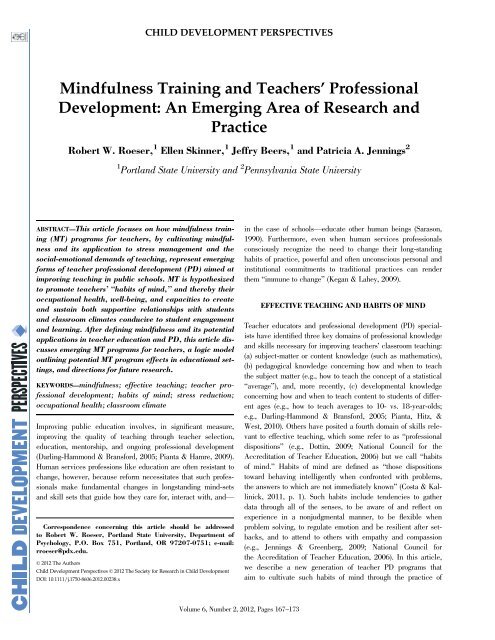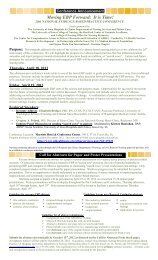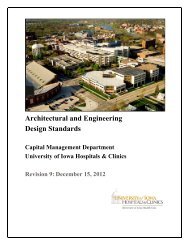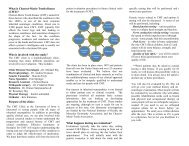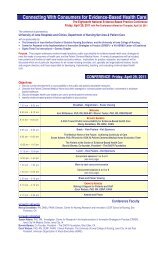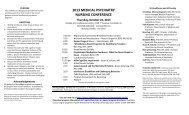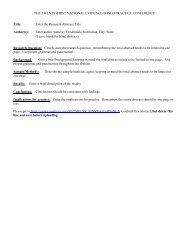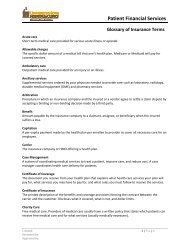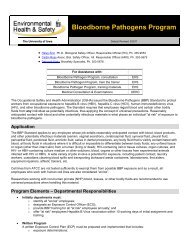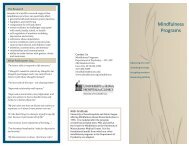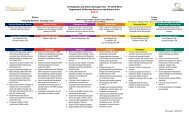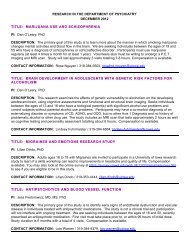Mindfulness Training and Teachers Professional Development: An ...
Mindfulness Training and Teachers Professional Development: An ...
Mindfulness Training and Teachers Professional Development: An ...
Create successful ePaper yourself
Turn your PDF publications into a flip-book with our unique Google optimized e-Paper software.
CHILD DEVELOPMENT PERSPECTIVES<br />
<strong>Mindfulness</strong> <strong>Training</strong> <strong>and</strong> <strong>Teachers</strong>’ <strong>Professional</strong><br />
<strong>Development</strong>: <strong>An</strong> Emerging Area of Research <strong>and</strong><br />
Practice<br />
Robert W. Roeser, 1 Ellen Skinner, 1 Jeffry Beers, 1 <strong>and</strong> Patricia A. Jennings 2<br />
1 Portl<strong>and</strong> State University <strong>and</strong> 2 Pennsylvania State University<br />
ABSTRACT—This article focuses on how mindfulness training<br />
(MT) programs for teachers, by cultivating mindfulness<br />
<strong>and</strong> its application to stress management <strong>and</strong> the<br />
social-emotional dem<strong>and</strong>s of teaching, represent emerging<br />
forms of teacher professional development (PD) aimed at<br />
improving teaching in public schools. MT is hypothesized<br />
to promote teachers’ “habits of mind,” <strong>and</strong> thereby their<br />
occupational health, well-being, <strong>and</strong> capacities to create<br />
<strong>and</strong> sustain both supportive relationships with students<br />
<strong>and</strong> classroom climates conducive to student engagement<br />
<strong>and</strong> learning. After defining mindfulness <strong>and</strong> its potential<br />
applications in teacher education <strong>and</strong> PD, this article discusses<br />
emerging MT programs for teachers, a logic model<br />
outlining potential MT program effects in educational settings,<br />
<strong>and</strong> directions for future research.<br />
KEYWORDS—mindfulness; effective teaching; teacher professional<br />
development; habits of mind; stress reduction;<br />
occupational health; classroom climate<br />
Improving public education involves, in significant measure,<br />
improving the quality of teaching through teacher selection,<br />
education, mentorship, <strong>and</strong> ongoing professional development<br />
(Darling-Hammond & Bransford, 2005; Pianta & Hamre, 2009).<br />
Human services professions like education are often resistant to<br />
change, however, because reform necessitates that such professionals<br />
make fundamental changes in longst<strong>and</strong>ing mind-sets<br />
<strong>and</strong> skill sets that guide how they care for, interact with, <strong>and</strong>—<br />
Correspondence concerning this article should be addressed<br />
to Robert W. Roeser, Portl<strong>and</strong> State University, Department of<br />
Psychology, P.O. Box 751, Portl<strong>and</strong>, OR 97207-0751; e-mail:<br />
rroeser@pdx.edu.<br />
© 2012 The Authors<br />
Child <strong>Development</strong> Perspectives © 2012 The Society for Research in Child <strong>Development</strong><br />
DOI: 10.1111/j.1750-8606.2012.00238.x<br />
in the case of schools—educate other human beings (Sarason,<br />
1990). Furthermore, even when human services professionals<br />
consciously recognize the need to change their long-st<strong>and</strong>ing<br />
habits of practice, powerful <strong>and</strong> often unconscious personal <strong>and</strong><br />
institutional commitments to traditional practices can render<br />
them “immune to change” (Kegan & Lahey, 2009).<br />
EFFECTIVE TEACHING AND HABITS OF MIND<br />
Teacher educators <strong>and</strong> professionaldevelopment(PD)specialists<br />
have identified three key domains of professional knowledge<br />
<strong>and</strong> skills necessary for improving teachers’ classroom teaching:<br />
(a) subject-matter or content knowledge (such as mathematics),<br />
(b) pedagogical knowledge concerning how <strong>and</strong> when to teach<br />
the subject matter (e.g., how to teach the concept of a statistical<br />
“average”), <strong>and</strong>, more recently, (c) developmental knowledge<br />
concerning how <strong>and</strong> when to teach content to students of different<br />
ages (e.g., how to teach averages to 10- vs. 18-year-olds;<br />
e.g., Darling-Hammond & Bransford, 2005; Pianta, Hitz, &<br />
West, 2010). Others have posited afourthdomainofskillsrelevant<br />
to effective teaching, which some refer to as “professional<br />
dispositions” (e.g., Dottin, 2009; National Council for the<br />
Accreditation of Teacher Education, 2006) but we call “habits<br />
of mind.” Habits of mind are defined as “those dispositions<br />
toward behaving intelligently when confronted with problems,<br />
the answers to which are not immediately known” (Costa & Kallinick,<br />
2011, p. 1). Such habits include tendencies to gather<br />
data through all of the senses, to be aware of <strong>and</strong> reflect on<br />
experience in a nonjudgmental manner, to be flexible when<br />
problem solving, to regulate emotion <strong>and</strong> be resilient after setbacks,<br />
<strong>and</strong> to attend to others with empathy <strong>and</strong> compassion<br />
(e.g., Jennings & Greenberg, 2009; National Council for<br />
the Accreditation of Teacher Education, 2006). In this article,<br />
we describe a new generation of teacher PD programs that<br />
aim to cultivate such habits of mind through the practice of<br />
Volume 6, Number 2, 2012, Pages 167–173
168 Robert W. Roeser et al.<br />
mindfulness, a particular way of deploying attention <strong>and</strong> awareness<br />
in the present moment in a nonreactive <strong>and</strong> nonjudgmental<br />
manner that facilitates emotion regulation, stress reduction, <strong>and</strong><br />
healthy social interactions (see Kabat-Zinn, 1994; Mind & Life<br />
Education Research Network [MLERN], 2012).<br />
TEACHING AS UNCERTAIN, EMOTIONAL, AND<br />
ATTENTIONALLY DEMANDING WORK<br />
Why are habits of mind necessary for effective teaching<br />
Human service occupations like teaching, because of their<br />
social nature, involve high levels of uncertainty, emotion, <strong>and</strong><br />
attention to others, <strong>and</strong> thus require habits of mind associated<br />
with mental flexibility, emotion regulation, <strong>and</strong> relationship<br />
management skills (Helsing, 2007; Schutz & Zembylas, 2009;<br />
Zapf, 2002). Furthermore, given that social relationships inevitably<br />
engender conflict, human service professionals also require<br />
habits of mind associated with working with conflict creatively,<br />
being resilient after conflicts, <strong>and</strong> practicingforgiveness <strong>and</strong><br />
relationship reengagement after conflict.<br />
As a case in point, teachers’ work lives are saturated with<br />
interactions with students, colleagues, administrators, <strong>and</strong> parents—interactions<br />
that require significant attentional <strong>and</strong> emotional<br />
resources <strong>and</strong> their effective regulation through habits of<br />
mind. For instance, teachers must often shift the focus of their<br />
attention in the classroom from particular students <strong>and</strong> their<br />
cognitive <strong>and</strong> emotional needs, to an overview of the entire<br />
classroom, <strong>and</strong> back again. By cultivating the habit of being<br />
flexibly attentive, teachers may be better able to respond to<br />
students’ needs proactively, a key contributor to effective<br />
classroom management (Marzano, Marzano, & Pickering,<br />
2003). In addition, teachers must problem solve “on the fly”<br />
as they interact with students of varying levels of maturity <strong>and</strong><br />
readiness to learn. To do this in a manner that avoids unequal<br />
treatment <strong>and</strong> opportunities to learn among students with different<br />
backgrounds requires great awareness, empathy, <strong>and</strong><br />
mental flexibility. Furthermore, in all of their interactions at<br />
work, teachers must use age-appropriate language <strong>and</strong> nonverbal<br />
behavior. They must recruit <strong>and</strong> express a range of socially<br />
appropriate emotions (such as enthusiasm, interest, or intentionally<br />
expressed displeasure) <strong>and</strong>, at the same time, they<br />
must regulate more distressing emotions like frustration or fear<br />
that can arise in such interactions (e.g., Chang, 2009). Emotion<br />
regulation is especially important because if teachers<br />
become overly stressed in the classroom, they cannot leave in<br />
order to compose themselves but must self-regulate in the<br />
presence of the class <strong>and</strong> the stressor itself (such as a student’s<br />
disruptive behavior).<br />
Given these kinds of routine dem<strong>and</strong>s, it is unsurprising<br />
that research has shown teaching to be a very stressful occupation<br />
(Johnson et al., 2005). Between 25% <strong>and</strong> 30% of<br />
teachers rate their jobs as either very or extremely stressful<br />
(Kyriacou, 2001; Unterbrink et al., 2007). Studies of teacher<br />
burnout—emotional exhaustion, low personal accomplishment,<br />
<strong>and</strong> depersonalization of students—reveal that teachers in<br />
developed countries have similar rates of burnout (e.g., Bauer<br />
et al., 2006; Borg, 1990). Occupational stress seems particularly<br />
grueling for teachers early in their careers, with rates<br />
of leaving the profession estimated to be as high as 46% in<br />
the first 5 years (Jalongo & Heider, 2006). However, even<br />
teachers who remain in the profession show the cumulative<br />
effects of stress <strong>and</strong> burnout. In Germany, for instance,<br />
only 26% of teachers—compared to 54% of other public<br />
employees—continue to work until the normal retirement age<br />
(Statistisches Budesamt, 2005). Researchshowsthat52%of<br />
early retirements among teachers are caused by psychiatric<br />
<strong>and</strong>/or psychosomatic disorders (Weber, Weltle, & Lederer,<br />
2002, 2004). In other developed countries, teachers demonstrate<br />
similar relations between chronic occupational stress<br />
<strong>and</strong> symptoms of mental <strong>and</strong> physical health problems (e.g.,<br />
Johnson et al., 2005; Kyriacou, 1987; McCarthy, Lambert,<br />
O’Donnell, & Melendres, 2009; Montgomery & Rupp, 2005).<br />
Given the uncertain <strong>and</strong> emotionally dem<strong>and</strong>ing nature of<br />
teaching, when teachers do not develop the habits of mind to<br />
manage relevant resources <strong>and</strong> dem<strong>and</strong>s effectively, it can lead<br />
to problems that undermine teacher well-being <strong>and</strong> instructional<br />
practice. Such negative outcomes have consequences in<br />
education, both economic <strong>and</strong> student related. Unmanaged<br />
stress not only undermines teacher well-being, it also engenders<br />
health care <strong>and</strong> human resource costs associated with<br />
teacher illness, absenteeism, <strong>and</strong> leaving the profession. <strong>An</strong>d<br />
teachers who have not developed the kinds of habits of mind<br />
we are discussing here may not be reaching their full potential<br />
to create emotionally supportive classroom climates for student<br />
learning (Briner & Dewberry, 2007; Jennings & Greenberg,<br />
2009).<br />
Surprisingly, neither teacher education nor PD programs currently<br />
prepare teachers for these kinds of job dem<strong>and</strong>s (Jennings<br />
&Greenberg,2009)eventhough,asHargreaves(2000)notes,<br />
“teaching, learning <strong>and</strong> leading may not be solely emotional<br />
practices, but they are always irretrievably emotional in character,<br />
in a good way or a bad way, by design or default” (p. 812).<br />
Given studies showing that mindfulness training (MT) with adults<br />
can help with stress reduction, emotion regulation, health, <strong>and</strong><br />
prosocial dispositions (see Fredrickson, Cohn, Coffey, Pek, &<br />
Finkel, 2008; Grossman, Niemann, Schmidt, & Walach, 2004;<br />
MLERN, 2012; Shapiro, Oman, Thoresen, Plante, & Flinders,<br />
2007), there has been growing interest in using MT to help teachers<br />
develop habits of mind so that they are better prepared to<br />
meet the dem<strong>and</strong>s of their jobs. Furthermore, given their position<br />
in society in affecting the development of so many young people,<br />
teachers seem ideally suited for becoming expert in such habits<br />
of mind <strong>and</strong> imparting them to their students as well through role<br />
modeling <strong>and</strong> direct instruction (e.g., Partnership for 21st Century<br />
Skills, 2012). A brief summary of selected mindfulness training<br />
programs for teachers is presented in Table 1.<br />
Child <strong>Development</strong> Perspectives, Volume 6, Number 2, 2012, Pages 167–173
<strong>Mindfulness</strong> <strong>Training</strong> <strong>and</strong> Teacher <strong>Development</strong> 169<br />
Table 1<br />
Sampling of current mindfulness-based programs for teachers<br />
Program<br />
Cultivating Awareness <strong>and</strong> Resilience<br />
in Education (CARE for <strong>Teachers</strong>)<br />
http://www.garrisoninstitute.org/care<br />
Stress Management <strong>and</strong> Relaxation<br />
Techniques (SMART-in-<br />
Education)<br />
http://www.smart-in-education.org/<br />
http://margaretcullen.com/<br />
Inner Resilience<br />
http://www.innerresiliencetidescenter.org/<br />
<strong>Mindfulness</strong>, Courage, <strong>and</strong> Reflection<br />
for Educators<br />
http://umassmed.edu/cfm<br />
Mindful Schools<br />
http://www.mindfulschools.org/<br />
Passsageworks Soul of Education<br />
Course for <strong>Teachers</strong><br />
http://passageworks.org/<br />
Program focus<br />
4-day, 36-h program held over the course of 5–6 weekswithintersessioncoachingprovidedto<br />
participants by phone to support theapplicationofCAREskills.Itisalsoofferedasaweek-longretreat<br />
at the Garrison Institute. CARE utilizes three primary instructional components: (a) emotion skills<br />
instruction, (b) mindfulness <strong>and</strong> stress reduction practices, <strong>and</strong> (c) listening <strong>and</strong> compassion exercises.<br />
Program components are linked to specific strategies for improving classroom managment, teacher–<br />
student relationships, <strong>and</strong> instructional strategies<br />
8-week, 34.5-h program <strong>and</strong> 15-min daily home practice. Promotes skills sets (e.g., regulation of attention<br />
<strong>and</strong> emotion) <strong>and</strong> mind-sets (e.g., dispassionate curiosity, compassion <strong>and</strong> forgiveness for self <strong>and</strong><br />
others) associated with mindfulness that are conducive to occupational health <strong>and</strong> well-being <strong>and</strong><br />
teachers’ capacities to become more effective teachers. This training includes group discussions, dyadic<br />
exercises, didactic presentations <strong>and</strong> practices such as breath awareness meditation, mindfulness<br />
meditation, loving-kindness <strong>and</strong> forgiveness meditations, a progressive “body scan,” <strong>and</strong> mindful<br />
movement<br />
Promotes the skills of self-regulation <strong>and</strong> caring for others through residential retreats for school staff,<br />
professional development workshops, individual stress reduction sessions, <strong>and</strong> parent workshops at<br />
school sites<br />
Ablendofmindfulness-basedstressreduction(MBSR) programing <strong>and</strong> the Courage to Teach Program<br />
Online <strong>and</strong> live training for educators <strong>and</strong> administrators in the form of courses, curriculum trainings, <strong>and</strong><br />
customized mindfulness workshops<br />
This 2.5-day program focuses on building heart, spirit, <strong>and</strong> community in the classroom. The program<br />
covers the theory of social <strong>and</strong> emotional learning, the integration of play, ritual, stillness, expressive<br />
arts <strong>and</strong> community building, developing reflection, <strong>and</strong> “teaching presence”<br />
MINDFULNESS TRAINING AND THE CULTIVATION OF<br />
TEACHERS’ HABITS OF MIND<br />
Kabat-Zinn (1994) defined mindfulness as “paying attention in a<br />
particular way: on purpose, in the present moment, <strong>and</strong> nonjudgmentally”<br />
(p. 4). As such, mindfulness can be understood as<br />
involving three interrelated mental skills <strong>and</strong> dispositions: (a)<br />
concentrating attention intentionally on the here <strong>and</strong> now; (b)<br />
perceiving the present moment in a calm, clear, <strong>and</strong> veridical<br />
manner; <strong>and</strong> (c) experiencing each momentjustasitis,without<br />
biasing mental reactions or judgments (Young, 2011). <strong>Mindfulness</strong><br />
is traditionally taught through structured contemplative<br />
practices in which attention is focused intentionally <strong>and</strong> nonjudgmentally<br />
on present-moment somatic <strong>and</strong> mental experience<br />
in the form of bodily sensations, feelings,mentalimages,<strong>and</strong><br />
thoughts (Young, 2011). Such practices can include body scans,<br />
in which participants focus their attention progressively throughout<br />
the body to bring awareness to somatic experience; meditation<br />
on the breath to develop concentration; <strong>and</strong> meditation on<br />
present-moment experience to bring awareness to the body, feelings,<br />
images, <strong>and</strong> thoughts <strong>and</strong> to develop insight <strong>and</strong> equanimity<br />
with regard to all facets of present-moment experience (Kabat-<br />
Zinn, 1994). A fourth closely related practice, loving-kindness<br />
meditation, uses focused attention intheserviceofcultivating<br />
positive emotion toward oneself <strong>and</strong> others (Salzberg, 1995).<br />
In addition to these contemplative practices, MT programs for<br />
teachers such as those listed in Table1alsoincludeexplicit<br />
instruction on emotions <strong>and</strong> stress, <strong>and</strong> on how to use mindfulness<br />
to regulate emotions <strong>and</strong> stress more effectively (Bishop<br />
et al., 2004; Chambers, Gullone, & Allen, 2009). In these kinds<br />
of MT programs, the application of mindfulnessskillstothespecific<br />
dem<strong>and</strong>s of teaching is supported throughout by weekly<br />
meetings involving group mindfulness practice <strong>and</strong> discussions<br />
of practice, by listening to recordings of prescribed home mindfulness<br />
practices, <strong>and</strong> by homework assignments in which teachers<br />
are invited to apply the skills of mindfulness to some aspect<br />
of their teaching <strong>and</strong> report back to the group. For instance, in<br />
one program, teachers keep a mindful emotion diary for 1 week,<br />
documenting their emotions, “emotional triggers,” <strong>and</strong> ways of<br />
coping in the classroom. They then discuss these diaries in a<br />
subsequent meeting <strong>and</strong> explore how mindfulness might help.<br />
During other weeks, teachers are invited to offer thoughts of<br />
Child <strong>Development</strong> Perspectives, Volume 6, Number 2, 2012, Pages 167–173
170 Robert W. Roeser et al.<br />
kindness <strong>and</strong> compassion to their most challenging student <strong>and</strong><br />
to a student whom they rarely pay attention to, <strong>and</strong> to observe<br />
the effects of doing so on their underst<strong>and</strong>ing of <strong>and</strong> relationships<br />
with those students over time.<br />
Figure 1 presents a logic model describing the hypothesized<br />
effects of such MT programs on teachers. The model holds that<br />
mindfulness training, through its effects on the cultivation of<br />
teachers’ mindfulness <strong>and</strong> related habits of mind (such as tolerance<br />
for uncertainty, attentional focus, cognitive flexibility, <strong>and</strong><br />
emotion regulation), improves teachers’ occupational health <strong>and</strong><br />
well-being. Increased health <strong>and</strong> well-being among teachers<br />
should lead to greater occupational engagement <strong>and</strong> satisfaction<br />
<strong>and</strong> lower rates of absenteeism, occupational burnout, health<br />
care use, <strong>and</strong> leaving the profession because of stress <strong>and</strong> burnout.<br />
<strong>Teachers</strong>’ mindful habits of mind, in conjunction with their<br />
greater occupational health, well-being, <strong>and</strong> engagement, should<br />
then support the formation of positive dyadic relationships<br />
between teachers <strong>and</strong> students <strong>and</strong> provide teachers with the<br />
attentional <strong>and</strong> emotional resources <strong>and</strong> regulatory control they<br />
require to create <strong>and</strong> maintain emotionally supportive classroom<br />
climates in which all students can learn.<br />
Supportive teacher–student relationships <strong>and</strong> classroom climates<br />
for learning, in turn, should promote students’ feelings<br />
of belonging in the classroom <strong>and</strong> thereby enhance their levels<br />
of participation <strong>and</strong> engagement in learning. When students<br />
have supportive relationships with teachers, feel they are valued<br />
members of a learning community, <strong>and</strong> are positively<br />
involved in classroom activities, we hypothesize that they will<br />
be less likely to be disruptive, oppositional, or silently alienated<br />
<strong>and</strong> therefore will require fewer disciplinary referrals. At<br />
the same time, students in such environments should learn<br />
more because of their greater engagement <strong>and</strong> on-task behavior.<br />
As Figure 1 shows, there are alsotwosetsofhypothesized<br />
feedback loops in our model, in which positive student outcomes<br />
should contribute over time to (a) even more supportive<br />
teacher–student relationships <strong>and</strong> positive classroom climates,<br />
<strong>and</strong> (b) increased teacher occupation health, well-being,<br />
engagement, <strong>and</strong> satisfaction. Taken together, these processes<br />
should form self-amplifying “virtuous” cycles, characterized by<br />
positive reciprocal relationships between teachers’ <strong>and</strong> students’<br />
enjoyment, engagement, <strong>and</strong> satisfaction with teaching<br />
<strong>and</strong> learning together.<br />
FUTURE DIRECTIONS FOR RESEARCH ON MT FOR<br />
TEACHERS<br />
The logic model in Figure 1 leads toaseriesoftractablescientific<br />
research questions that require empirical scrutiny. First <strong>and</strong><br />
foremost, do MT programs designed for teachers actually lead to<br />
the kinds of habits of mind that we describe here If so, do<br />
mindfulness <strong>and</strong> related habits of mind actually affect the<br />
teacher outcomes, classroom outcomes, <strong>and</strong> student outcomes<br />
specified downstream in the model What kinds of methodologies<br />
<strong>and</strong> research designs are needed to assess the hypothesized<br />
chains of effect in this logic model How can the field produce<br />
rigorous research evidence that speaks to the educational community’s<br />
need for consumption <strong>and</strong> translation of research into<br />
practice These kinds of questions are at the heart of an emerging<br />
research agenda focused on MT programs for teachers <strong>and</strong><br />
their potential direct effects on teachers <strong>and</strong> indirect effects on<br />
classrooms <strong>and</strong> students. We highlight a few issues that seem<br />
particularly important to address in the near term as practice<br />
<strong>and</strong> research in this area continue to grow.<br />
Research Designs <strong>and</strong> Methods<br />
Research on the effects of MT on teachers, classrooms, <strong>and</strong> students<br />
should take advantage of a variety of methodologies,<br />
including case studies, longitudinal studies, <strong>and</strong> r<strong>and</strong>omized<br />
controlled trials (RCTs). Because the field is so new, “phenomena<br />
finding” investigations that use richethnographicdescriptions,<br />
case studies of exemplars, <strong>and</strong>otherformsofqualitative<br />
assessment of mindfulness <strong>and</strong> MT in education seem particularly<br />
important.<br />
In addition, given that most research on teacher development<br />
uses cross-sectional designs with relatively small samples of<br />
convenience, we also need longitudinal designs with representative<br />
samples to ascertain the antecedents <strong>and</strong> consequences of<br />
various forms of PD, including MT, on teachers’ development<br />
across their occupational life courses (Schonfeld, 1992). Using<br />
longitudinal designs to examine the long-term effects of MT on<br />
teacher outcomes such as work attendance, health care utilization,<br />
<strong>and</strong> leaving the profession, as well as student engagement,<br />
achievement, <strong>and</strong> equity, seems particularly important given<br />
that these potential outcomes are likely to manifest on different<br />
timescales <strong>and</strong> that both teacher <strong>and</strong> student outcomes are of<br />
relevance to school districts <strong>and</strong> states today.<br />
Also key in future research is the use of RCTs to determine<br />
MT’s effectiveness in producing the results in the outcomes<br />
specified in Figure 1 compared to waitlist or active control<br />
groups. RCTs are particularly important for establishing the efficacy<br />
<strong>and</strong> effectiveness of these kinds of programs across different<br />
geographical areas <strong>and</strong> populations of teachers <strong>and</strong> students,<br />
as well as for elucidating issues of program fidelity <strong>and</strong> feasibility<br />
that are critical to evaluating the long-term prospects of scaling<br />
<strong>and</strong> sustaining these kinds of programs in schools.<br />
Research Measures<br />
Multimethod, multitrait, <strong>and</strong> multi-informant measures are<br />
needed to establish the empirical <strong>and</strong> practical significance of<br />
MT programs <strong>and</strong> to capture all the outcomes specified in Figure<br />
1. To assess the proximal habits of mind hypothesized to<br />
result from mindfulness training, we need the kinds of rigorous,<br />
third-person cognitive-behavioral measures used in experimental<br />
studies of executive functioning. To assess outcomes such as<br />
teachers’ stress, burnout, <strong>and</strong> general health, we need measures<br />
of biological factors (such as cortisol, inflammatory cytokines, or<br />
Child <strong>Development</strong> Perspectives, Volume 6, Number 2, 2012, Pages 167–173
<strong>Mindfulness</strong> <strong>Training</strong> <strong>and</strong> Teacher <strong>Development</strong> 171<br />
Figure 1.<br />
Logic model of hypothesized mindfulness training effects on teachers, classroom environments, <strong>and</strong> students.<br />
heart-rate variability). To get at outcomes such as teacher wellbeing,<br />
perceived stress <strong>and</strong> burnout, <strong>and</strong> job satisfaction, we<br />
need first-person self-report measures. Self-report measures are<br />
also useful for gathering students’ perceptions of their teachers<br />
<strong>and</strong> their relationships with them before <strong>and</strong> after MT. Students,<br />
as well as principals or spouses, represent important third-person<br />
“key informants” on the effects of training on teachers.<br />
Third-person, observational measures of classroom teaching<br />
behavior are also critical to this work in order to move it beyond<br />
individual outcomes toward an underst<strong>and</strong>ing of mindfulness in<br />
the classroom. Finally, official school records are important for<br />
assessing teacher attendance, health care utilization, office referrals<br />
of students, <strong>and</strong> student achievement in objective ways.<br />
Dose–Response Relations<br />
<strong>An</strong>other important issue concerns a determination of dose–<br />
response relations, or how much mindfulness training is feasible<br />
<strong>and</strong> efficacious to produce effects on teachers, classrooms, <strong>and</strong><br />
students. MT programs often require a significant time commitment<br />
from teachers who already have hectic work lives. Some<br />
evidence suggests that shorter programs can still engender significant<br />
effects for adults (e.g., Klatt, Buckworth, & Malarkey,<br />
2009). What is the optimal feasible amount of training that is<br />
effective In our own work (SMART <strong>and</strong> CARE; see Table 1),<br />
we have been experimenting with programs of various durations<br />
(length in hours) delivered over various periods of time (5 vs.<br />
8weeks).Usingsimilarmeasurestocompareprogramsofdifferent<br />
lengths is one way to address the dose–response relation in<br />
these programs.<br />
Contexts of Reception or Rejection<br />
Finally, we think it is critical for researchers to carefully attend<br />
to the factors that facilitate or hinder the introduction of mindfulness<br />
programs into teacher education <strong>and</strong> PD in school districts<br />
<strong>and</strong> various communities. What kinds of changes going on<br />
in education today might provide unique opportunities to introduce<br />
MT for teachers (e.g., McDonald & Shirley, 2009) What<br />
do states <strong>and</strong> school districts need, <strong>and</strong> how might this particular<br />
kind of training be useful in addressing such needs Are<br />
there any risks associated with these kinds of programs<br />
In our work, we have found that current concerns about<br />
teacher stress <strong>and</strong> health care costs represent one way MT can<br />
enter school systems, <strong>and</strong> concerns about enhancing student<br />
engagement <strong>and</strong> achievement represent a second possible entry<br />
point. Also, concerns about disproportionate rates of school suspensions<br />
<strong>and</strong> expulsions by student race <strong>and</strong> ethnicity, <strong>and</strong> the<br />
related desire among educators to foster greater educational<br />
equity, represent another possible point of entry.<br />
Teacher Programs, Student Programs<br />
In this article, we discussed MT programs for teachers that may<br />
have indirect effects on students. However, as Greenberg <strong>and</strong><br />
Harris (2012) discuss, there are a number of new MT <strong>and</strong> yoga<br />
programs for students at the elementary <strong>and</strong> secondary school<br />
levels. The question arises, how should practitioners <strong>and</strong><br />
researchers think about linking teacher- <strong>and</strong> student-focused<br />
MT programs If districts adopt MTprograms,shouldtheyconsider<br />
offering programs for teachers first, <strong>and</strong> then train their<br />
own teachers to deliver MT to students We believe this “systems<br />
approach” is likely to be the most effective (e.g., Sarason,<br />
1990), but RCT studies that assess the effects of combining MT<br />
for teachers <strong>and</strong> students versus the effects of teacher programs<br />
only, student programs only, or active controls should examine<br />
this conjecture directly in the future.<br />
CONCLUSION<br />
Improving public education involves, in significant measure, the<br />
improvement of the quality of teaching <strong>and</strong> teachers’ professional<br />
development. We have outlined how certain dimensions<br />
Child <strong>Development</strong> Perspectives, Volume 6, Number 2, 2012, Pages 167–173
172 Robert W. Roeser et al.<br />
of teachers’ work, including its uncertain <strong>and</strong> emotionally<br />
dem<strong>and</strong>ing nature, make habits of mind a particularly important<br />
part of being an effective teacher. MT is only beginning to be<br />
used to foster teachers’ habits of mind <strong>and</strong> thereby to help them<br />
to meet <strong>and</strong> succeed in the context of the dem<strong>and</strong>s of teaching<br />
in the 21st century (see Table 1), <strong>and</strong> the research base is still<br />
nascent. <strong>An</strong> empirical exploration of MT for teachers as one<br />
piece of an overall effort to support the development of teachers<br />
<strong>and</strong> the improvement of public education seems warranted. We<br />
look forward to the expansion of this area educational theory,<br />
research, <strong>and</strong> practice in the future.<br />
REFERENCES<br />
Bauer, J., Stamm, A., Virnich, K., Wissing, K., Muller, U., Wirsching,<br />
M., et al. (2006). Correlation between burnout syndrome <strong>and</strong> psychological<br />
<strong>and</strong> psychosomatic symptoms among teachers. International<br />
Archives of Occupational <strong>and</strong> Environmental Health, 79,<br />
199–204.<br />
Bishop, S. R., Lau, M., Shapiro, S., Carlson, L., <strong>An</strong>derson, N., Carmody,<br />
J., et al. (2004). <strong>Mindfulness</strong>: A proposed operational definition.<br />
Clinical Psychology: Science <strong>and</strong> Practice, 11,230–241.<br />
Borg, M. G. (1990). Occupational stress in British educational settings:<br />
Areview.Educational Psychology, 10,410–443.<br />
Briner, R., & Dewberry, C. (2007). Staff well-being is key to school success.London:WorklifeSupportLtd/HamiltonHouse.<br />
Chambers, R., Gullone, E., & Allen, N.B.(2009).Mindfulemotion<br />
regulation. <strong>An</strong> integrative review. Clinical Psychology Review, 29,<br />
560–572.<br />
Chang, M. (2009). <strong>An</strong> appraisal perspective of teacher burnout: Examining<br />
the emotional work of teachers. Educational Psychology<br />
Review, 21,193–218.<br />
Costa, A. L., & Kallinick, B. (2011). Describing 16 habits of mind.<br />
Retrieved January 1, 2011, from http://www.instituteforhabitsofmind.com<br />
Darling-Hammond, L., & Bransford, J., Eds. (2005). Preparing teachers<br />
for a changing world: What teachers should learn <strong>and</strong> be able to do.<br />
San Francisco: Jossey-Bass.<br />
Dottin, E. S. (2009). <strong>Professional</strong> judgment <strong>and</strong> dispositions in teacher<br />
education. Teaching <strong>and</strong> Teacher Education, 25,83–88.<br />
Fredrickson, B. L., Cohn, M. A., Coffey, K. A., Pek, J., & Finkel, S. M.<br />
(2008). Open hearts build lives: Positive emotions, induced through<br />
loving-kindness meditation, build consequential personal<br />
resources. Journal of Personality <strong>and</strong> Social Psychology, 95,1045–<br />
1062.<br />
Greenberg, M. T., & Harris, A. R. (2012). Nurturing mindfulness in children<br />
<strong>and</strong> youth: Current state of research. Child <strong>Development</strong> Perspectives,<br />
6,161–166.<br />
Grossman, P., Niemann, L., Schmidt, S., & Walach, H. (2004). <strong>Mindfulness</strong>-based<br />
stress reduction <strong>and</strong> health benefits: A meta-analysis.<br />
Journal of Psychosomatic Research, 57,35–43.<br />
Hargreaves, A. (2000). ixed emotions: <strong>Teachers</strong>’ perceptions of their<br />
interactions with students. Teaching <strong>and</strong> Teacher Education, 16,<br />
811–826.<br />
Helsing, D. (2007). Regarding uncertainty in teachers <strong>and</strong> teaching.<br />
Teaching <strong>and</strong> Teacher Education, 23,1317–1333.<br />
Jalongo, M. R., & Heider, K. (2006). Editorial teacher attrition: <strong>An</strong> issue<br />
of national concern. Early Childhood Education Journal, 33, 379–<br />
380.<br />
Jennings, P. A., & Greenberg, M. (2009). The prosocial classroom:<br />
Teacher social <strong>and</strong> emotional competence in relation to child<br />
<strong>and</strong> classroom outcomes. Review of Educational Research, 79,<br />
491–525.<br />
Johnson, S., Cooper, C., Cartwright, S., Donald, I., Taylor, P., & Millet,<br />
C. (2005). The experience of work-related stress across occupations.<br />
Journal of Managerial Psychology, 20,178–187.<br />
Kabat-Zinn, J. (1994). Wherever you go, there you are: <strong>Mindfulness</strong> meditation<br />
in everyday life.NewYork:Hyperion.<br />
Kegan, K., & Lahey, L. L. (2009). Immunity to change: How to overcome<br />
it <strong>and</strong> unlock potential in yourself <strong>and</strong> your organization. Boston:<br />
Harvard Business School Publishing.<br />
Klatt, M. D., Buckworth, J., & Malarkey, W. B. (2009). Effects of lowdose<br />
mindfulness-based stress reduction (MBSR-Id) on working<br />
adults. Health Education <strong>and</strong> Behavior, 36,601–614.<br />
Kyriacou, C. (1987). Teacher stress <strong>and</strong> burnout: <strong>An</strong> international<br />
review. Educational Research, 29,146–152.<br />
Kyriacou, C. (2001). Teacher stress: Directions for future research. Educational<br />
Review, 53,27–35.<br />
Marzano, R. J., Marzano, J. S., & Pickering, D. J. (2003). Classroom<br />
management that works.Alex<strong>and</strong>ra,VA:ASCD.<br />
McCarthy, C. J., Lambert, R. G., O’Donnell, M., & Melendres, L. T.<br />
(2009). The relation of elementary teachers’ experience, stress, <strong>and</strong><br />
coping resources to burnout symptoms. Elementary School Journal,<br />
109,282–300.<br />
McDonald, E., & Shirley, D. (2009). The mindful teacher. NewYork:<br />
<strong>Teachers</strong>’ College Press.<br />
Mind <strong>and</strong> Life Education Research Network. (2012). Contemplative<br />
practices <strong>and</strong> mental training: Prospects for American education.<br />
Child <strong>Development</strong> Perspectives, 6,146–153.<br />
Montgomery, C., & Rupp, A. A. (2005). A meta-analysis exploring the<br />
diverse causes <strong>and</strong> effects of stress in teachers. Canadian Journal<br />
of Education, 28,458–486.<br />
National Council for the Accreditation of Teacher Education. (2006).<br />
<strong>Professional</strong> st<strong>and</strong>ards for the accreditation of schools, colleges, <strong>and</strong><br />
departments of education. RetrievedOctober4,2006,fromhttp://<br />
www.ncate.org/public/unitSt<strong>and</strong>ardsRubrics.aspch=4<br />
Partnership for 21st Century Skills (2012). Framework for 21st century<br />
learning. Retrieved March 21, 2012, from http://www.p21.org/<br />
overview<br />
Pianta, R. C., & Hamre, B. K. (2009). Conceptualization, measurement<br />
<strong>and</strong> improvement of classroom processes: St<strong>and</strong>ardized observation<br />
can leverage capacity. Educational Researcher, 38,109–119.<br />
Pianta, R. C., Hitz, R., & West, B. (2010). Increasing the application of<br />
developmental sciences knowledge in teacher preparation. Washington,<br />
DC: NCATE.<br />
Salzberg, S. (1995). Loving-kindness: The revolutionary art of happiness.<br />
Boston: Shambhala.<br />
Sarason, S. B. (1990). The predictable failure of school reform. SanFrancisco:<br />
Jossey-Bass.<br />
Schonfeld, I. S. (1992). A longitudinal study of occupational stressors<br />
<strong>and</strong> depressive symptoms in first-year female teachers. Teaching<br />
<strong>and</strong> Teacher Education, 8,151–158.<br />
Schutz, P. A., & Zembylas, M., (Eds. 2009). Advances in teacher emotion<br />
research: The impact on teachers’ lives.NewYork:Springer.<br />
Shapiro, S., Oman, D., Thoresen, C., Plante, T., & Flinders, T. (2007).<br />
Cultivating mindfulness: Effectsonwell-being.Journal of Clinical<br />
Psychology, 64,840–862.<br />
Statistisches Budesamt. (2005). Press release. Retrieved December 9,<br />
2005, from http://www.destatis.de<br />
Child <strong>Development</strong> Perspectives, Volume 6, Number 2, 2012, Pages 167–173
<strong>Mindfulness</strong> <strong>Training</strong> <strong>and</strong> Teacher <strong>Development</strong> 173<br />
Unterbrink, T., Hack, A., Pfeifer, R., Buhl-Griehaber, V., Müller, U.,<br />
Wesche, H., et al. (2007). Burnout <strong>and</strong> effort-reward-imbalance in<br />
asampleof949Germanteachers.International Archives of Occupational<br />
<strong>and</strong> Environmental Health, 80,433–441.<br />
Weber, A., Weltle, D., & Lederer, P.(2002).ZurProblematikkrankheitsbedingter<br />
Frühpensionierungen von Gymnasiallehrkräften.<br />
Versicherungsmedizin, 54,75–83.<br />
Weber, A., Weltle, D., & Lederer, P. (2004). Frühinvalidität imLehrberuf:<br />
Sozial und arbeitsmedizinische Aspekte. Deutsches A¨rzteblatt,<br />
101,712–718.<br />
Young, S. (2011). Five ways to know yourself: <strong>An</strong> introduction to basic<br />
mindfulness.Unpublishedmanuscript.<br />
Zapf, D. (2002). Emotion work <strong>and</strong> psychological well-being: A review<br />
of the literature <strong>and</strong> some conceptual considerations. Human<br />
Resource Management Review, 12,1–32.<br />
Child <strong>Development</strong> Perspectives, Volume 6, Number 2, 2012, Pages 167–173


